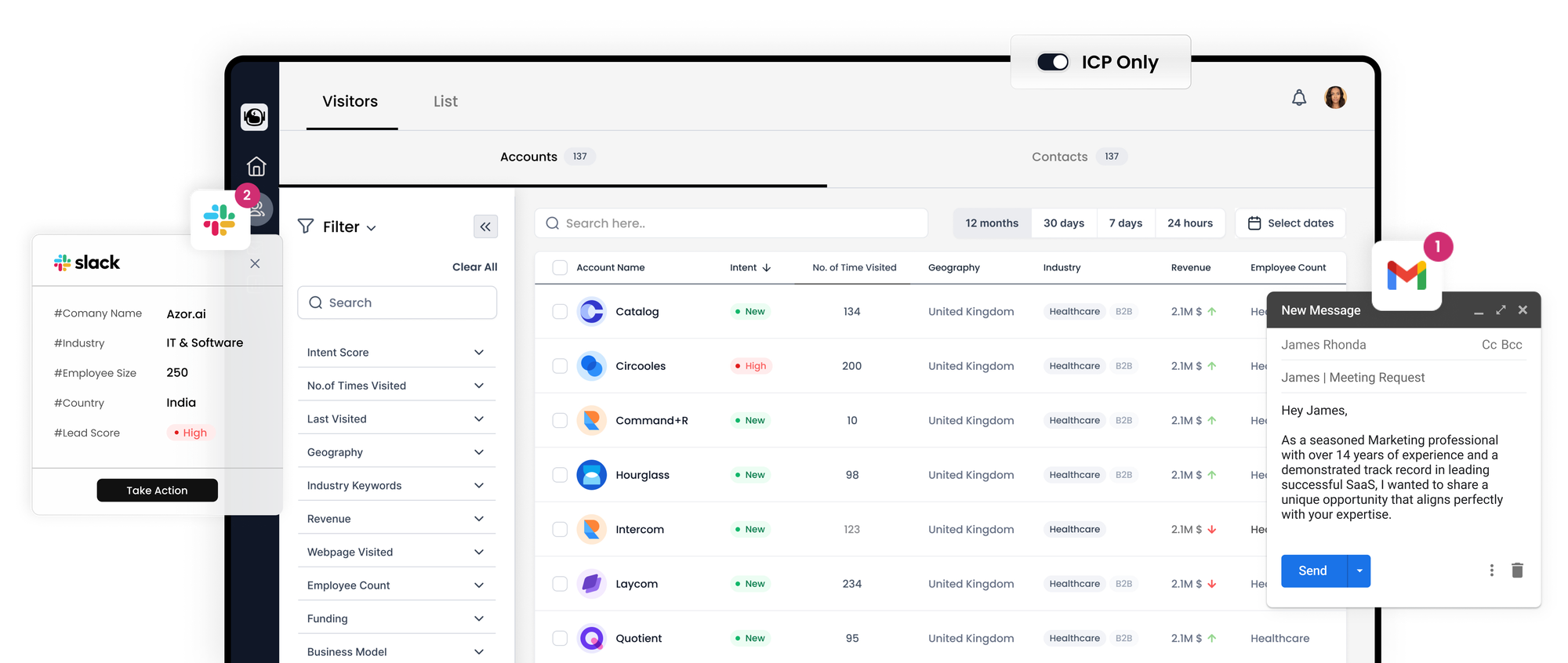A Comprehensive Overview of Website Visitor Tracking for B2B Sales and Marketing

Understanding the importance of website visitor tracking is crucial for sales and marketing teams, especially considering the challenge of converting website visitors into customers. Despite significant efforts to attract visitors, a vast majority often leave without engaging further. To address this, implementing effective strategies to convert and extract maximum value from the non-converting majority is essential.
The integration of website visitor tracking software is a transformative solution for illuminating the anonymous majority of website traffic. It opens up new opportunities for identifying and converting potential leads that might otherwise remain unnoticed.

What is Website Visitor Tracking?
Website visitor tracking moves beyond basic analytics like page views, offering a deeper insight into the identities behind these numbers. Tools designed for tracking website visitors reveal crucial information about your visitors, including company affiliation and key contact details. This information enables sales and marketing teams to create detailed customer profiles, enhancing lead generation and conversion efforts.
Advantages of Website Visitor Tracking:
1. **For Marketing Teams:**
- Data-driven strategy development: Understand what content engages your ideal prospects.
- Increased lead generation: Leverage current traffic more effectively for lead generation.
- Enhanced Account-Based Marketing (ABM) campaigns: Utilize visitor data for more targeted ABM strategies.
2. **For Sales Teams:**
- Access to warm leads: Easily identify companies interested in your products or services.
- Reduced reliance on cold outreach: Focus on nurturing potential customers who have already shown interest.
- Improved efficiency: Spend less time finding leads and more time converting them.
The Mechanism Behind Website Visitor Tracking:
1. **Reverse Domain Name System (rDNS):** This process uses the IP addresses of visitors to identify the companies they belong to, filtering out irrelevant traffic like ISPs or bots.
2. **Installation of Tracking Script:** A script is installed on your website which directly collects visitor data and enriches it with publicly available information about the visiting companies.
3. **Integration with CRM and Other Tools:** Syncing visitor tracking data with your existing tool stack, like CRM systems, provides a fuller picture of potential customers and their activities.
GDPR Compliance:
It's essential to ensure GDPR compliance when implementing tracking software. This involves being transparent about data collection and usage, and having clear, accessible privacy policies on your website.
Utilizing Visitor Tracking for Growth:
1. **Lead Generation:**
- Identify and prioritize high-value leads based on website activity.
- Sync leads to CRM for efficient sales team follow-up.
2. **Optimizing the Marketing Funnel:**
- Analyze visitor data at each funnel stage to identify and fix drop-off points.
- Use data to guide prospects more effectively through the funnel.
3. **Boosting Account-Based Marketing:**
- Use visitor data to refine and target ideal company profiles.
- Monitor engagement from ABM campaigns and adjust strategies accordingly.
Practical Implementation:
1. **Lead Generation Enhancement:**
- View profiles of companies visiting your site.
- Prioritize leads showing similar behaviors to previous conversions.
2. **Marketing Funnel Analysis:**
- Track visitor paths through the funnel.
- Implement fixes based on where previous leads have dropped off.
3. **Account-Based Marketing (ABM) Strategy:**
- Build profiles of ideal targets based on actual site visitors.
- Use data to inform ABM campaign targets and measure effectiveness.
Website visitor tracking thus emerges as a pivotal tool for transforming your marketing and sales strategies, turning your website into a more powerful lead-generation engine. It aligns sales and marketing efforts, enabling a more focused approach to nurturing and converting prospective clients.
Comprehensive Guide to Leveraging Website Visitor Tracking for Marketing Teams
Understanding website visitor tracking is vital for marketing teams aiming to improve their campaigns and convert more visitors into customers. Beyond just driving traffic to your website, it's crucial to focus on converting visitors and maximizing value from the majority who don't immediately engage.
Here are six practical applications of website visitor tracking to enhance marketing efforts:
1. Developing Detailed Buyer Personas:
Buyer personas are critical in defining your ideal customer, including their demographics, job titles, interests, and pain points. These personas guide targeted marketing strategies. Website visitor tracking provides real data to build accurate personas, revealing characteristics like industry, company size, and location of website visitors. Utilizing this data in creating personas ensures strategies are based on actual visitor behavior rather than assumptions.
2. Mapping the Buyer’s Journey:
Tracking tools help understand the path from first visit to conversion. Analyze metrics like page views, time spent on content, and conversion paths. This information enables the creation of more effective marketing funnels and strategies to guide visitors towards conversion more efficiently.
3. Enhancing Content Strategy:
Utilize visitor tracking to identify which content resonates with your target audience. Analyze which types of content are most engaging, how long visitors spend on different content types, and the channels driving traffic. Use these insights to refine your content strategy, focusing on what works best for your audience.
4. Boosting Lead Generation:
Website visitor tracking allows identification of companies and individuals showing interest in your services. Integrate this data with your CRM to prioritize high-potential leads for follow-up, refining lead generation tactics based on actual visitor interest and behavior.
5. Strengthening Account-Based Marketing (ABM):
ABM is about delivering personalized marketing to key accounts. Visitor tracking helps identify the characteristics of companies visiting your site, aiding in creating more targeted ABM campaigns. Monitor the engagement of these companies with your content and adjust strategies for higher effectiveness.
6. Tracking Campaign Effectiveness:
Combine UTM parameters with visitor tracking for a comprehensive view of campaign performance. Track which companies are engaging with specific campaigns and their journey from initial click to final sale. This enables the creation of more effective, targeted campaigns in the future.
Case Study: Triuvare's Strategic Use of Visitor Tracking
Triuvare, an IT services agency, successfully used Leadfeeder to improve their content marketing strategy and increase conversions. By focusing on a key piece of content - their ICT Tendering Guide - they identified companies viewing this page as high-potential leads. Prioritizing contact with these leads led to improved content strategy ROI and more effective customer acquisition.
In summary, website visitor tracking is a powerful tool for marketing teams, offering insights into visitor behavior and enabling more targeted and effective marketing strategies. By understanding who is visiting your site and how they interact with your content, you can refine your marketing efforts for better engagement, lead generation, and conversion.
Comprehensive Guide on Website Visitor Tracking for Sales Teams
Sales teams, like their marketing counterparts, can significantly benefit from website visitor tracking. This technology not only identifies high-potential leads but also provides insights for effective outreach. Here's a breakdown of seven practical ways sales teams can leverage website visitor tracking:
1. Identifying Sales Leads Efficiently:
A common challenge for 61% of B2B marketers is generating high-quality leads. Website visitor tracking eases this by identifying potential leads among website visitors. For example, sales reps can quickly pinpoint mid-size companies from the US with 100-200 employees visiting their site, fitting their ideal customer profile. This information streamlines the lead identification process, saving valuable time.
2. Connecting with Decision-Makers Directly:
Visitor tracking tools not only reveal company details but also allow sales teams to identify key decision-makers within these companies. This information, integrated with CRM systems, can help sales reps to find and target relevant contacts more effectively, reducing the time spent on lead search.
3. Warming Up Cold Outreach:
Prior to direct outreach, sales teams can engage with potential leads on social platforms. Interacting with company tweets, blog posts, or LinkedIn activities can warm up leads before direct contact, making subsequent sales pitches more receptive.
4. Leveraging Introductions for Networking:
Utilizing mutual connections for introductions can be more effective than cold outreach. LinkedIn, for instance, can be used to request introductions to prospects, enhancing the chances of a positive response.
5. Creating Lead Scores for Prioritization:
Lead scoring, based on website activity and company profiles, helps sales teams prioritize their outreach efforts. This process involves ranking leads based on their activities and characteristics, focusing on those most likely to convert.
6. Automating Alerts for Timely Follow-Ups:
Setting up alerts for when target companies visit the website can help sales teams to reach out at the optimal time. This immediate follow-up can capitalize on the interest shown by the potential customer.
7. Personalizing Sales Messages:
Personalization in sales messages can significantly increase engagement and conversion rates. By analyzing the website behavior of potential leads, sales reps can tailor their messages to address specific pain points or interests of each company.
Case Study: AlertOps Increases Sales Demo Rates
AlertOps, an IT alert management platform, faced challenges in connecting with leads through cold outreach. By implementing Leadfeeder, they could identify prospects’ on-site activities and integrate this information with their CRM. This enabled them to personalize their outreach, resulting in a 700% increase in sales demo rates.
Summary
In today's marketing landscape, where consumers are inundated with messages, standing out requires more strategic efforts. Website visitor tracking offers sales teams a way to understand and anticipate the needs of their prospects better. By identifying potential leads, understanding their behavior, and personalizing outreach, sales teams can enhance their effectiveness, leading to higher conversion rates and improved sales performance.
